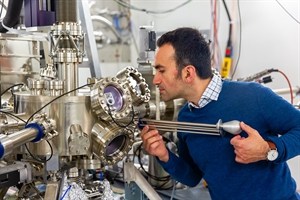A network of interconnected atoms could be used to construct a “quantum brain” that mimics how a real brain learns. The new system consists of an array of cobalt atoms on a substrate of black phosphorous, and its developers at Radboud University in the Netherlands say that it could have applications in artificial intelligence.
The human brain contains some 100 billion neurons in connected networks. Whenever we perform a task, these neurons receive electrical signals from other neurons in their network via tiny junction-like structures known as synapses. Once the sum of the signals across the synapses reaches a certain critical value, the neuron “fires” by sending a series of voltage spikes to other neurons. The strength of the connection between different neurons is known as the synaptic weight and can change over time as we learn new things and perform new tasks.
Many of today’s brain-inspired, or neuromorphic, devices use machine learning – the process by which a computer uses software, or algorithms, to train on a given set of examples – to autonomously develop the ability to perform a new task. One such machine-learning model is known as a Boltzmann machine. In physical terms, a Boltzmann machine is an interacting (Ising) system of spins in which randomly fluctuating spins (or magnetic moments) represent neurons.
Magnetic atoms on surfaces are emerging as a platform for realizing such a machine, as it is possible to use them to create tuneable networks of spins that display the necessary random motion. The problem is that magnetic exchange interactions between these atoms usually have a short range, which limits the number of connections to other atoms/neurons that can be formed.
Individually-coupled cobalt atoms
Researchers led by Alexander Khajetoorians and Hilbert Kappen have now created a self-adapting Boltzmann machine by exploiting the orbital dynamics of individually-coupled cobalt atoms placed on black phosphorus. The new work builds on earlier experiments in which they discovered that it is possible to store binary bits of information (0s and 1s) in the electronic state of a single cobalt atom when it is placed on this two-dimensional semiconductor and a voltage is applied to the atom.
Khajetoorians, Kappen and colleagues used the tip of a scanning tunnelling microscope to position the cobalt atoms on the 2D material and create long-range coupling between the atoms. They found that when they applied a voltage to the atom network, it produced an output signal that comes from electrons “hopping” from one cobalt atom to another. This output signal somewhat resembles the firing produced by neurons.
Synaptic weight change
As well as observing spiking behaviour in the output signals, the researchers noticed that the ensembles of cobalt atoms behaved differently depending on what input they received. For example, when the material was stimulated over a longer period with a certain voltage, the synapse-like memory-bearing atoms autonomously reorganized in response – in effect, changing their synaptic weight. “The material learned by itself,” Khajetoorians says.

Electrically tuneable network learns fast
Wolfram Pernice, a physicist and nanotechnologist at the University of Münster in Germany who was not involved in the study, calls the new work “very nice”. “Particularly exciting is the fact that the learning process is implemented directly in the material,” he tells Physics World. “Using individual atoms to implement artificial neurons and synapses is very elegant.”
Khajetoorians and colleagues say they now plan to scale up their system into a larger network of cobalt atoms. They would also like to study other magnetic atoms in an effort to understand why these atom networks behave the way they do. They report their findings in Nature Nanotechnology.
